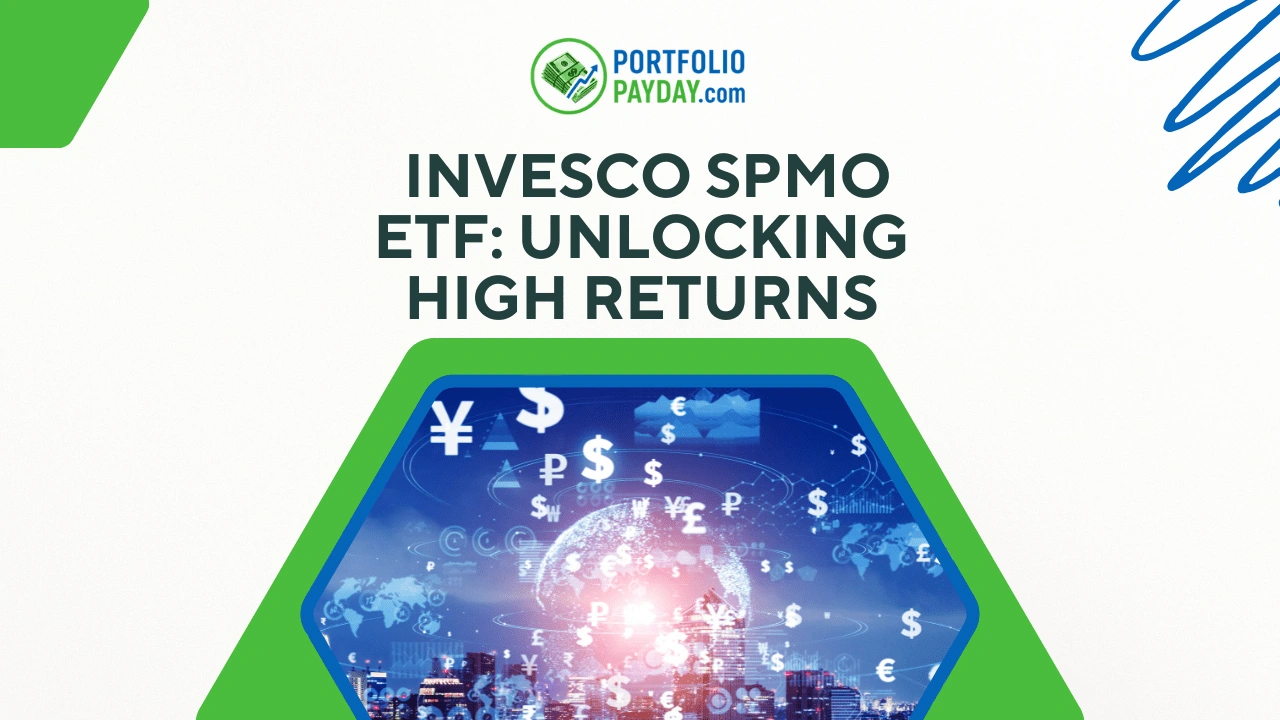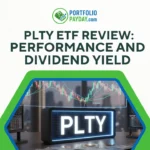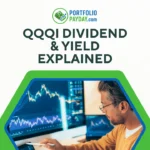Disclaimer: The following is for informational purposes only and not financial advice. Always do your own due diligence. I am not a licensed advisor.
Understanding SPMO Holdings and Its Dividend Potential: A Deep Dive Into the Invesco S&P 500 Momentum ETF
The world of Exchange-Traded Funds (ETFs) is vast, and for investors seeking to capitalize on market momentum, the Invesco S&P 500 Momentum ETF (SPMO) is quickly becoming a standout choice. Since its inception in 2015, SPMO has demonstrated impressive returns, and its momentum-based strategy has caught the attention of savvy investors.
In this article, we’ll explore the fundamentals of SPMO holdings, how it works, its potential for future growth, and why it could be a key addition to your portfolio. But more importantly, we’ll look at the risks and strategies surrounding SPMO, especially its dividend yields and how its performance might unfold in various market conditions.
What is the Invesco S&P 500 Momentum ETF (SPMO)?
SPMO is an ETF that tracks the S&P 500 Momentum Index, which selects the top 100 companies in the S&P 500 based on their price momentum over the past year, excluding the most recent month. The fund’s goal is to allocate a larger weight to stocks that have exhibited strong performance recently, operating under the assumption that stocks that have done well in the past will continue to outperform in the future.
Unlike traditional ETFs that weigh stocks based purely on their market capitalization, SPMO adds a momentum factor to this calculation. This makes it different from other ETFs, like the S&P 500 or QQQ, which are market-cap weighted and do not consider momentum in the same way.
The fund’s holdings include high-performing stocks across sectors, with large companies like Nvidia, Meta, and Amazon often leading the charge. In fact, these top-performing companies have been driving a significant portion of SPMO’s returns over the past year.
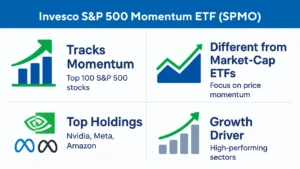
How Does Momentum Impact SPMO’s Performance?
Momentum investing is a strategy that seeks to capitalize on trends by buying stocks that have shown an upward trajectory in recent months. In essence, it’s about “chasing performance.” The idea is simple: the stocks that have performed well recently are likely to continue performing well.
SPMO evaluates its holdings based on price changes over the last 12 months and adjusts them by their volatility. This means that stocks with high price increases but low volatility will score higher, while stocks with high volatility but modest price gains will be penalized.
One key feature of SPMO is its biannual rebalancing. The ETF is rebalanced every March and September, which allows it to remain focused on the most momentum-driven stocks, rotating out underperformers as needed.
The Performance of SPMO: A Look at Recent Trends
SPMO’s performance in recent years has been extraordinary. In 2024, the ETF returned 47%, significantly outperforming both the S&P 500 and the NASDAQ 100 (QQQ). Over the last five years, it has returned 129%, while its all-time return has been nearly 300% in capital appreciation alone.
This performance is largely attributed to its focus on momentum stocks, especially in the technology sector, where companies like Nvidia have seen explosive growth due to the rise of artificial intelligence (AI) and other market-driving trends. Momentum has propelled SPMO into the spotlight, and investors are eager to tap into the potential for continued growth.
However, it’s important to note that momentum investing is not foolproof. In down markets, momentum strategies can sometimes lag behind traditional index funds, as was evident during the 2022 market downturn. While SPMO held up better than the broader market, it still faced challenges, especially when compared to more defensive strategies.

The Risks of SPMO and Momentum Investing
Like any investment, SPMO comes with risks. While its growth potential is undeniable, it’s important to understand that momentum strategies tend to work well in bull markets or market recoveries, but they can struggle during downturns. This was seen during the market correction of 2022, when SPMO was more resilient than the S&P 500 but still took a hit.
Additionally, SPMO’s concentrated portfolio is another factor that could pose risks. With 58% of its assets invested in the top 10 holdings, including companies like Meta, Nvidia, and Amazon, any downturn or underperformance in these companies could significantly impact the overall performance of the ETF.
Moreover, SPMO’s dividend yield is relatively low, sitting at around 0.50% annually. While this is typical for growth-focused ETFs, it’s important for investors looking for income-generating investments to be aware that SPMO’s primary appeal is its growth potential rather than its dividend payouts.
How SPMO Compares to Other ETFs
When compared to other popular ETFs like the QQQ and S&P 500, SPMO has been outpacing the competition in terms of growth. However, the ETF is more volatile and concentrated than its peers, which means it has the potential for higher upside, but also greater downside risk during market corrections.
Is SPMO a Good Investment for the Future?
Looking ahead, SPMO holds significant potential for investors looking to capitalize on momentum, especially with the AI revolution gaining traction. The ETF’s focus on high-performing tech stocks and its ability to adapt to changing market conditions make it an appealing choice for those seeking growth.
However, it’s essential to consider the market cycle when investing in momentum ETFs like SPMO. In an expansion phase, SPMO is likely to outperform, but in a market downturn, its performance might not hold up as well. For this reason, many investors may choose to pair SPMO with more defensive or value-oriented ETFs to balance out the risks.
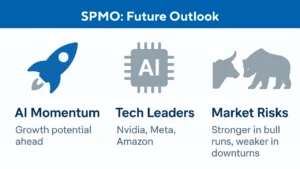
Should You Add SPMO to Your Portfolio?
The Invesco S&P 500 Momentum ETF offers a dynamic investment strategy that leverages recent market momentum to deliver impressive returns. While its recent performance has been exceptional, investors need to be aware of the risks, particularly in volatile market conditions.
If you’re looking for a growth-focused ETF with exposure to the market’s top momentum stocks, SPMO could be a great addition to your portfolio. However, be mindful of its concentrated portfolio, low dividend yield, and the fact that momentum investing can be unpredictable. Pairing SPMO with other ETFs could help mitigate some of these risks while still allowing you to take advantage of its upside potential.
